33 Yellow Flowering Shrubs (with Pictures): Identification Guide
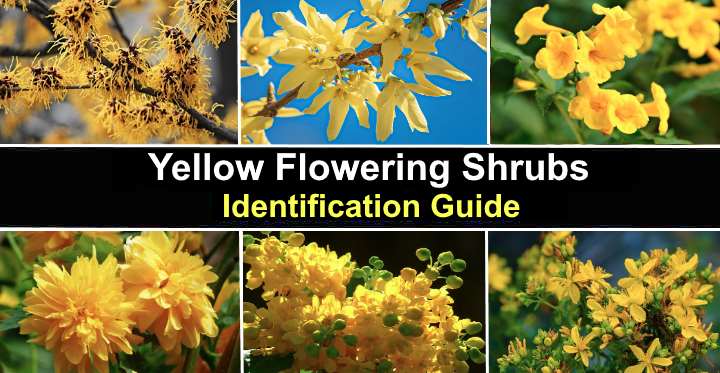
Yellow-flowering shrubs can add a bright and cheerful splash of sunshine to any front or backyard. Shrubs with yellow flowers are known for their vibrant colors, wonderful scents, and lush foliage. From the showy golden yellow blooms of forsythia, Pontic azaleas, and shrub roses to the delicate blossoms of bushy cinquefoil, there are many yellow-flowering shrubs to choose from.
Yellow-flowering deciduous shrubs with bright yellow blossoms fill gardens with radiant bursts of golden-lemon floral accents from spring through fall. On the other hand, evergreen shrubs with cheerful and bright yellow flowers keep your yard looking lush and vibrant all year. Whether you prefer a compact shrub or a tall, bushy plant, there is a yellow flowering shrub that suits your gardening needs.
In this identification guide, you will find pictures and descriptions of different types of yellow flowering shrubs to help you choose the perfect addition to your garden.
What Are Yellow Flowering Shrubs?
Yellow-flowering shrubs are bushy, multi-stemmed plants with yellow blossoms. Shrubs typically grow 1 to 7 ft. (0.3 – 2.1 m) tall; however, some can be larger. Yellow shrubs enhance gardens and landscapes with their striking colors, providing aesthetic value, boosting curb appeal, and often attracting pollinators when blooming from spring through fall.
How to Identify Yellow Flowering Shrubs
Identifying yellow flowering shrubs requires looking at the bushy plant’s key features. Often, you can tell the variety of yellow shrubs by their leaf shape, type of flower, and bloom time. Also, check for unique features like thorns, distinctive bark, and the type of foliage—evergreen or deciduous.
In many cases, looking at pictures of yellow shrubs can help identify the correct plant variety. This information is essential for identifying yellow-flowering shrubs suitable for your growing zone, sun exposure, and soil type.
Yellow Flowering Shrubs (with Pictures): Identification Guide
Let’s look in more detail at some of the most popular yellow flowering shrubs available.
Forsythia (Forsythia)
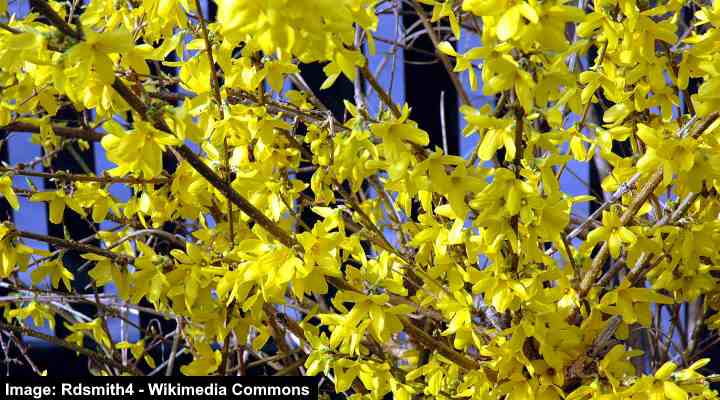
The bright yellow blooms of Forsythia shrubs are one of the earliest signs of spring. Forsythia is a deciduous shrub known for its vibrant yellow flowers that bloom on bare, wiry stems. Fast-growing, vigorous forsythia shrubs create a vivid floral spring display before the dark green foliage appears. Its fall color is purple or burgundy.
The forsythia is easily identified by its upright branches covered in golden-yellow, four-petaled flowers. The sun-loving shrub grows 8 to 10 ft. (2.4 – 3 m) tall and easily grows in most landscapes. The yellow shrub is great for creating hedges, privacy screens, foundation plantings, or mixed garden borders.
Its drought and salt spray resistance also make yellow-flowering forsythia ideal for coastal gardens.
- Mature Size: 8 to 10 ft. (2.4 – 3 m) tall and 10 to 12 ft. (3 – 3.6 m) wide
- USDA Zone: 6 to 9
- Sun Exposure: Full sun to partial shade
- Soil Type: Moist, well-drained soil
Weeping Forsythia (Forsythia suspensa)

The weeping forsythia is a yellow-flowering shrub with arching branches that create a cascading effect. This ornamental plant is identified by its early blooming, vibrant yellow trumpet-shaped flowers, small, three-lobed leaves, and drooping branches. The spectacular yellow blooms are the first to appear in spring.
The weeping forsythia grows 6 to 10 feet (1.8 – 3 m) tall and wide. Its weeping branches, covered in yellow spring flowers, make a stunning focal point in the landscape, along borders, a foundation line, or as a hedge. The shrub’s cascading branches also make it perfect for growing over a wall or on a bank.
The yellow shrub colonizes easily as its long, trailing branches root when they touch the ground.
- Mature Size: 6 to 10 ft. (2.4 – 3 m) tall and wide
- USDA Zone: 6 to 8
- Sun Exposure: Full sun to partial shade
- Soil Type: Moist, well-drained soil
Pontic Azalea (Rhododendron luteum)

The pontic azalea is a medium-sized deciduous bushy plant with spectacular yellow clusters of funnel-shaped fragrant flowers. This yellow-flowering azalea has golden yellow flowers and lanceolate, deep green leaves that turn red, yellow, and orange in the fall. The striking azalea adds a bold pop of color and sweet fragrance when it blooms from late spring through summer.
The pontic azalea grows to a height and width of 4 to 5 ft. (1.2 – 1.5 m). It thrives in full sun or partial shade and is drought-tolerant once established. However, regular watering is necessary during dry periods. Pontic azalea is an excellent landscaping choice to introduce vibrant yellows to shrub borders, foundation plantings, hedges, or shade gardens.
- Mature Size: 4 to 5 ft. (1.2 – 1.5 m) tall and wide
- USDA Zone: 6 to 9
- Sun Exposure: Full sunlight or Partial shade
- Soil Type: Well-drained humus-rich soil that is constantly moist
Related reading: How to care for azalea bushes.
Yellow Rhododendron Shrubs (Rhododendron spp.)
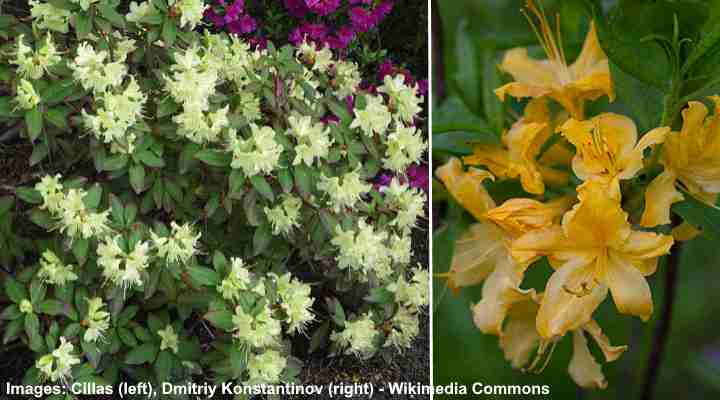
Rhododendron ‘Princess Anne’ (left) and rhododendron ‘Golden Lights’ (right)
Yellow-flowering rhododendron shrubs are eye-catching evergreen shrubs with blooms in various yellow shades. Rhododendrons are identified by their funnel-shaped showy flowers with protruding stamens, dark green, leathery leaves, and an attractive bronze color in the fall and winter. The yellow flowers bloom throughout spring.
Yellow rhododendron shrubs grow between 3 and 8 ft. (0.9 – 2.4 m) tall and wide, depending on the specific variety. Their yellow colors and showy blooms create stunning floral displays in shaded gardens. You can plant rhododendrons in mixed borders, foundation plantings, and as a flowering hedge.
- Mature Size: 3 to 8 ft. (0.9 – 2.4 m) tall and wide
- USDA Zone: 5 to 8
- Sun Exposure: Partial shade (but some varieties tolerate full sun)
- Soil Type: Fertile, well-drained, acidic soil
Here are some rhododendron varieties known for their dazzling yellow flowers:
Rhododendron ‘Saffron Queen’

The rhododendron ‘Saffron Queen’ is an upright evergreen shrub known for its vivid yellow funnel-shaped flowers growing in dense clusters. The shrub is known for its peeling bark and 3.5-inch (8.8 cm) long, glossy green leaves.
Rhododendron ‘Princess Anne’
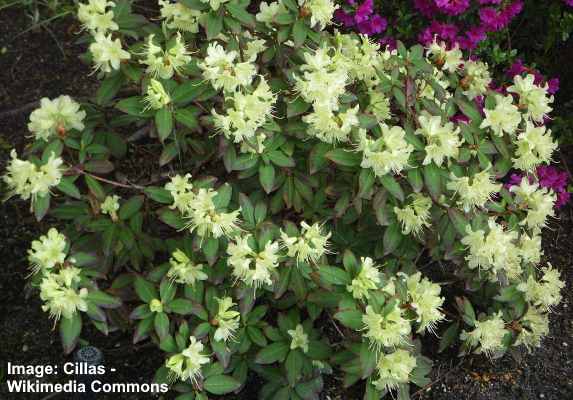
Rhododendron ‘Princess Anne’ is a type of dwarf azalea
The rhododendron ‘Princess Anne’ is a dwarf evergreen shrub with greenish-yellow trumpet-shaped flowers. The shrub has small dark green leaves that are a bronze shade when young or in winter.
Rhododendron ‘Golden Lights’

The rhododendron ‘Golden Lights’ is a compact, deciduous shrub with golden-yellow flowers that bloom in late spring through summer. The shrub is known for its exceptional cold hardiness down to -40°F (-40°C).
Rhododendron ‘Narcissiflorum’
The rhododendron ‘Narcissiflorum’ is a compact, medium-sized shrub that can be identified by its sweetly scented, pale yellow double flowers. It is cold hardy down to -15°F (-26°C).
Yellow Lady Banks Rose (Rosa banksiae ‘Lutea’)

The Yellow Lady Banks rose is a shrubby climbing rose identified by its yellow double blossoms. The rambling rose flowers are clusters of small, double yellow blooms that emit a sweet scent. The thornless branches have smooth-edged leaves and stay evergreen in mild climates. They can grow up to 20 ft. (6 m) tall.
The Yellow Lady Banks rose variety is the most floriferous of the banksia rose varieties. The pale yellow flowers cover the entire plant in spring and early summer. The yellow-flowering climbing rose shrub is ideal for growing over a fence or wall, pergolas, trellises, or other garden structures.
- Mature Size: 15 to 20 ft. (4.5 – 6 m) tall and 6 to 10 ft. (1.8 – 3 m) wide
- USDA Zone: 8 to 10
- Sun Exposure: Full sun
- Soil Type: Well-drained, moist soil with plenty of organic matter
Japanese Rose (Kerria japonica)
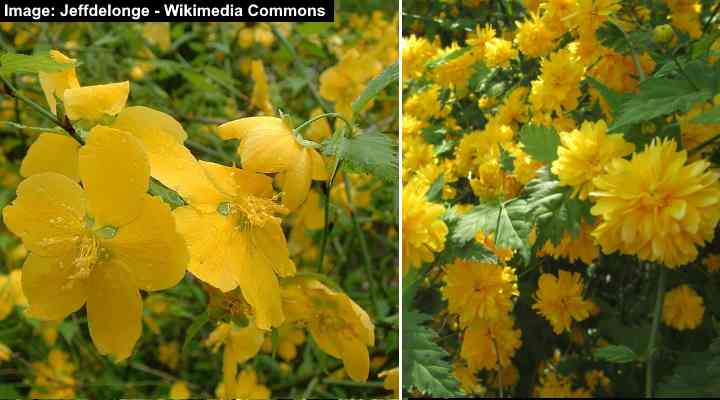
A Japanese rose shrub with single blooms (Kerria japonica) and double blooms (Kerria japonica ‘Pleniflora’)
The Japanese rose is a deciduous shrub known for its beautiful yellow flowers that bloom in early spring. It has single or double blooms (Kerria japonica ‘Pleniflora’) that resemble roses. This hardy, bushy plant has pom-pom-like cheerful and bright yellow flowers, small light green leaves, and yellow foliage in the fall. The unique shrub is also known for its attractive, bright green winter stems.
Low-maintenance Japanese rose shrubs grow up to 10 ft (3 m). Its tall, arching branches create an irregular shape that adds visual interest to front gardens. Ideal for growing in full shade, the yellow-flowering shrub is ideal for foundation plantings, informal flowering hedges, and shrub borders.
- Mature Size: 8 to 10 ft. (2.4 – 3 m) tall and wide
- USDA Zone: 4 to 9
- Sun Exposure: Full sun, partial shade, or full shade
- Soil Type: Medium moisture, well-drained soil
Sunny Knock-Out Rose (Rosa ‘Sunny Knock-Out’)

The sunny Knock-Out Rose is a popular yellow-flowering shrub rose that produces a profusion of attractive yellow flowers. The bright yellow and pastel cream flowers bloom continuously from spring through frost and contrast nicely with the shrub’s glossy foliage. The attractive shrub is known for its disease resistance and low maintenance requirements.
Sunny Knock-Out roses grow up to 4 ft. (1.2 m) tall and wide. The bushy plant with its long-blooming golden-hued flowers is ideal for planting in flower beds, borders, and along a foundation line. Additionally, it thrives in containers to add a splash of sunny colors to a patio, deck, or balcony.
- Mature Size: 3 to 4 ft. (0.9 – 1.2 m) tall and wide
- USDA Zone: 5 to 11
- Sun Exposure: Full sun or partial sun
- Soil Type: Organically rich, fertile, well-drained soil
Austrian Brier (Rosa foetida)

The Austrian brier is a yellow-flowering perennial rose with sunny, showy cup-shaped blossoms appearing in spring. Identifying features of the yellow shrubby rose are its deep yellow single flowers, pinnate leaves, thorny branches, and small red or orange fruits (rosehips). The sun-loving yellow shrub grows up to 6 ft. (1.8 m) tall.
Also called Austrian copper rose, the yellow-flowering Austrian brier is a versatile, hardy shrub that adds vibrant beauty to a rose garden. Its bright yellow shades are ideal for brightening mixed borders, rose gardens, foundation plantings, and growing in containers. Also, its dense, bushy growth and thorny stems make it a good privacy or security screen.
- Mature Size: 3 to 8 ft. (1 – 2.4 m) tall and wide
- USDA Zone: 4 to 9
- Sun Exposure: Full sun
- Soil Type: Organically rich, fertile soil with excellent drainage
Oregon Trail Rose (Rosa ‘Harison’s Yellow’)
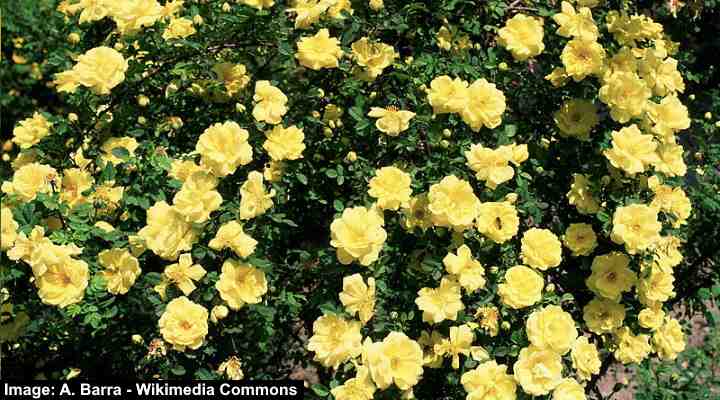
The Oregon trail ‘Harison’s Yellow’ is a compact, bushy shrub with clusters of yellow double flowers. Yellow-flowering shrub roses are known for their disease resistance and continuous blooming. The yellow Oregon trail roses grow up to 3 to 6 ft. (1 – 1.8 m) tall.
Oregon trail roses are low-maintenance shrubs that thrive in full sun and well-drained soil. This rose variety is great for adding bright colors, lush foliage, and floral fragrance to garden landscapes. You can also use the yellow blooms in cut flower bouquets and arrangements.
- Mature Size: 3 to 6 ft. (0.9 – 1.8 m)
- USDA Zone: 4 to 9
- Sun Exposure: Full sun
- Soil Type: Well-drained soil
Northern Spicebush (Lindera benzoin)

The northern spicebush is a yellow-flowering deciduous shrub native to North America. Identifying features of the early-blooming yellow shrub are its pale yellow flowers on bare branches, thick, pale green leaves 5” (12 cm) long, and bright red oval fruits. The shrub’s foliage turns golden-yellow in the fall.
The northern spicebush has aromatic foliage and fruit that emits a spicy fragrance when crushed. The tall, multi-stemmed shrub thrives in partial shade but tolerates full and partial sun. The large yellow-flowering shrub is ideal as a hedge or screen, and it thrives in marshy ground near streams and ponds.
- Mature Size: 6 to 12 feet (1.8 – 3.6 m) tall and wide
- USDA Zone: 4 to 9
- Sun Exposure: Full sun, partial shade, full shade
- Soil Type: Slightly acidic, moist, well-drained soils
Oregon Grape Holly (Mahonia aquifolium)
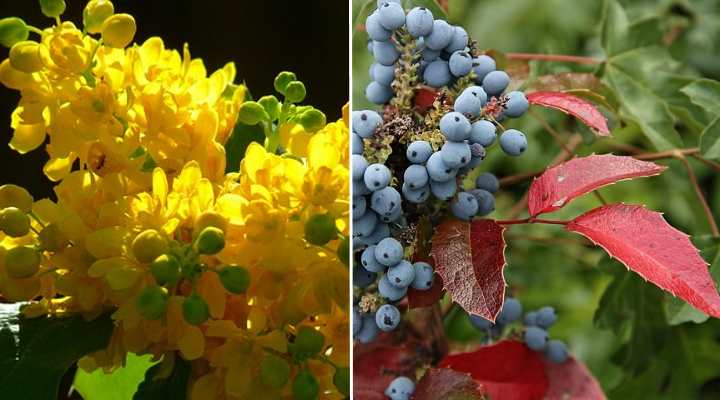
The Oregon grape holly is a versatile evergreen shrub with showy clusters of bright, golden-yellow flowers. Identifying features of this yellow-flowering shrub are its holly-like, spiny leaves, dense clusters of tiny yellow flowers, and bunches of bluish-black berries that attract birds. The shrub’s jagged leaves turn deep burgundy in the fall.
The Oregon grape holly is a slow-growing flowering shrub that grows up to 6 ft. (1.8 m) tall and has a dense, spreading growth habit. Suitable for growing in the shade, the yellow shrub performs well as a foundation plant, security screen, yellow-flowering hedge, and to attract pollinators. It’s also deer-resistant, making it a great choice for rural gardens.
- Mature Size: 3 to 6 ft. (1 – 1.8 m) tall and 2 to 5 ft. (0.6 – 1.5 m) wide
- USDA Zone: 5 to 8
- Sun Exposure: Partial shade to full shade
- Soil Type: Organically rich, acidic, moist, well-drained soil
Witch Hazel (Hamamelis virginiana)
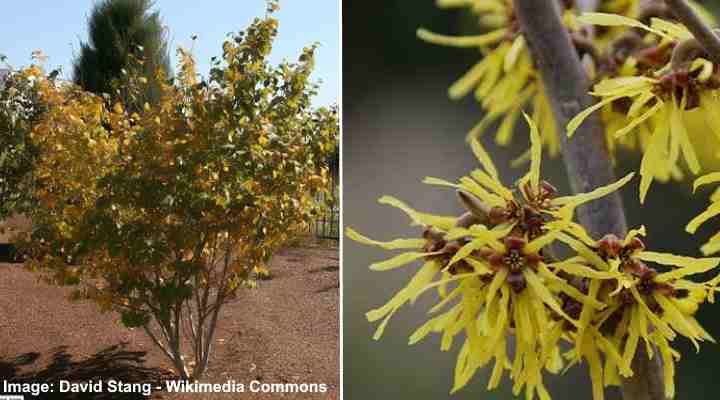
The common witch hazel is a deciduous shrub known for its unique and fragrant flowers with spindly yellow petals. The medium to large-sized yellow shrubs bloom in late winter and early spring. The shrub’s identifying features are its small, fragrant yellow flowers and oval green leaves that turn golden yellow in the fall.
Witch hazel shrubs can grow up to 20 feet (6 m) tall, and they have many uses in a backyard. The yellow-flowering shrubs are easy to grow and support native pollinators. The ribbon-like bright yellow to orange petals also look attractive in mixed borders, rain gardens, or growing as a hedge or specimen plant.
- Mature Size: 15 to 20 ft. (4.5 – 6 m) tall and wide
- USDA Zone: 3 to 8
- Sun Exposure: Full sun, partial shade, deep shade
- Soil Type: Organically rich, moist, well-drained soils, including heavy clay soils.
Lydian Broom (Genista lydia)
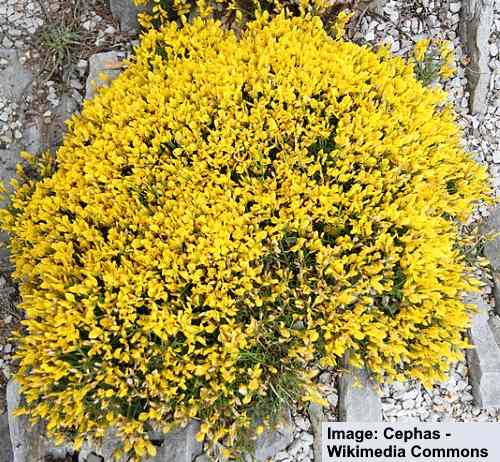
The Lydian broom is an attractive dwarf shrub that blooms with masses of bright yellow flowers in late spring and early summer. This compact shrub has clusters of pea-like yellow flowers, small, soft green leaves, and a cascading or trailing habit. Thriving in neglect, the yellow-flowering shrub grows up to 2 ft. (0.6 m) tall and wide.
Known for its profusion of vibrant yellow flowers, the Lydian broom is a low-maintenance, drought-tolerant shrub that can withstand hot, dry conditions. This shrub is ideal for yellow-flowering ground cover, rock gardens, growing on slopes, and in containers. The bright yellow flowers attract pollinators like bees and butterflies to the garden.
- Mature Size: 1 to 2 ft. (0.3 – 0.6 m) tall and wide
- USDA Zone: 4 to 9
- Sun Exposure: Full sun
- Soil Type: Poor, infertile soil that has excellent drainage
Spanish Broom (Genista hispanica)

Also called Spanish gorse, the low-growing deciduous shrub bursts into bright yellow colors in spring and summer. The identifying features of the yellow-flowering shrub are its pea-like flowers growing in starry clusters, spiny green stems with prickly leaves, and dense mounding habit. The sun-loving shrub thrives in poor soils.
The Spanish broom can grow up to 3 ft. tall (1 m) and has a spreading nature. The drought-tolerant yellow shrub is ideal for ground cover in full sun and xeriscape landscaping. It also performs well in rock gardens, slopes, borders, and in front of the house landscaping. It is also a great plant for attracting bees and butterflies to gardens.
- Mature Size: 2 to 3 ft. (0.6 – 1 m) tall and 4 to 5 ft. (1.2 – 1.5 m) wide
- USDA Zone: 7 to 9
- Sun Exposure: Full sun
- Soil Type: Poor, infertile, well-drained soils
Scotch Broom ‘Moonlight’ (Cytisus scoparius ‘Moonlight’)

The Scotch broom ‘Moonlight’ is a deciduous shrub with pale creamy-yellow pea-like flowers blooming on arching stems. The eye-catching feature of the yellow-flowering shrub is its spectacular spring floral displays. The fast-growing shrub also has deep green trifoliate leaves and fuzzy seed pods. It performs best in drought-prone, dry soils.
The Scotch broom ‘Moonlight’ cultivar grows up to 6 ft. (1.8 m) tall and has a compact growth habit. The abundance of fragrant, nectar-rich yellow flowers attracts bees and butterflies when it blooms in spring. Landscaping uses for the versatile shrub include beds and borders, coastal gardens, rock gardens, and xeriscaping.
- Mature Size: 5 to 6 ft. (1.5 – 1.8 m) tall and wide
- USDA Zone: 5 to 8
- Sun Exposure: Full sun
- Soil Type: Well-drained, infertile soils
Perforate St. John’s Wort (Hypericum perforatum)

The St. John’s Wort is a medium-sized shrub with bright yellow, five-petaled flowers in a star shape. The yellow flowers have open petals with yellow, wiry stamens in the center. These contrast with the lanceolate leaves that cover the upright green stems. St. John’s Wort blooms from early to late summer.
The St. John’s Wort is a common medicinal yellow shrub used in natural landscaping, borders, and ground cover. It’s low maintenance and generally disease and pest-free. It is also suitable for planting in a deer-resistant garden.
- Mature Size: 1 to 3 ft. (0.3 – 1 m) and 1 to 2 ft. (0.3 – 0.6 m) wide
- USDA Zone: 3 to 8
- Sun Exposure: Full sun to partial shade
- Soil Type: Medium moisture soil that drains well
Shrubby Cinquefoil (Potentilla fruticosa)

The shrubby cinquefoil is a compact flowering shrub that produces beautiful, rich yellow blooms throughout the summer. Identifying features of this hardy perennial shrub are its yellow flowers, which measure 1.5” (4 cm) across, tiny pinnate dark green leaves, and tolerance for cold and heat. The low-maintenance shrub also grows in most environments, including drought, coastal areas, and poor soils.
Also called golden hardhack, this shrubby plant grows up to 4 feet (1.2 m) tall and has a bushy, rounded habit. This versatile yellow-flowering shrub thrives in sunny conditions to add a splash of golden color to beds, borders, fence lines, or foundation plantings. It also performs well as an informal hedge.
- Mature Size: 2 to 4 ft. (0.6 – 1.2 m) and 3 to 5 ft. (1 – 1.5 m) wide
- USDA Zone: 3 to 7
- Sun Exposure: Full sun or partial shade
- Soil Type: Evenly moist, well-drained soils
Bush Honeysuckle (Diervilla lonicera)
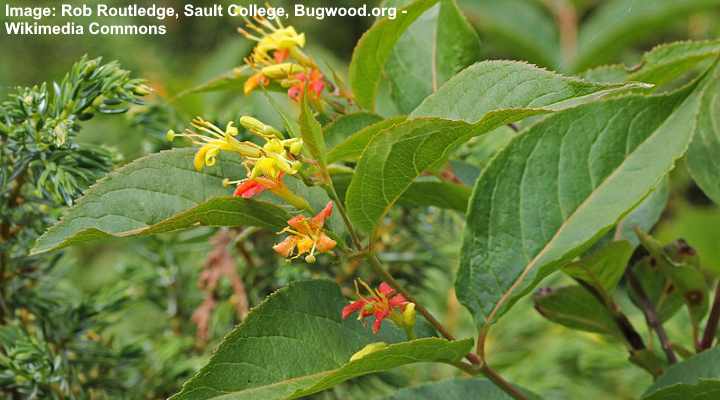
The bush honeysuckle is an eye-catching shrub with masses of yellow to orange trumpet-shaped flowers. The pretty flowers resemble honeysuckle flowers, and the pale yellow and coral red colors contrast beautifully against the lanceolate, glossy leaves. The foliage emerges coppery green and turns attractive shades of red, orange, and yellow in the fall.
The bush honeysuckle grows up to 3 ft. (1 m) tall. The yellow-orange blossoms bloom in pairs or groups of three in late summer and early fall. The nectar-rich flowers attract hummingbirds, butterflies, and bees to gardens. The drought-tolerant suckering shrub performs well as a low hedge or shrub border, or it can grow as ground cover.
- Mature Size: 2 to 3 ft. (0.6 – 1 m)
- USDA Zone: 3 to 7
- Sun Exposure: Full sun to partial shade
- Soil Type: Dry to medium moisture soil that has excellent drainage
Japanese Barberry ‘Artropurpurea Nana’ (Berberis thunbergii ‘Artropurpurea Nana’)

The Japanese barberry is a compact woody shrub known for its vibrant red foliage and thorny branches. The spectacular low-growing shrub has leaves that turn fiery shades of red in the fall. Also, small yellowish flowers appear in the spring alongside reddish to purple foliage. In the fall, bright red berries remain on stems after the leaves have dropped.
This dwarf shrub with red foliage grows 1 to 2 ft. (0.3 – 0.6 m) tall and spreads up to 3 ft. (1 m) wide. The drought and pollution-tolerant red-leaved shrub is excellent for colorful ground cover, growing in mass in borders, or decorating a rock garden.
- Mature Size: 1 to 2 ft. (0.3 – 0.6 m) and 2 to 3 ft. (0.6 – 1 m) wide
- USDA Zone: 4 to 8
- Sun Exposure: Full sun to partial shade
- Soil Type: Dry to medium, well-drained soil
Yellow Bells (Tecoma stans)

The yellow bells is a showy flowering shrub with stunning clusters of bright golden-yellow, funnel-shaped flowers. Also called yellow trumpetbush, the shrub blooms continuously from spring through late fall. Other features of the yellow-flowering shrub are its bright green pinnate leaves, long, arching stems, and bean-like seed pods.
Growing as a large shrub or small tree, the yellow bells grows up to 25 ft. (8 m) tall. However, pruning can help manage its height to 6 to 8 ft. (1.8 – 2.4 m). This low-maintenance yellow shrub is ideal for adding elegant floral accents to garden borders, hedges, and containers.
Yellow bells are native to the southwestern United States and are popular flowering shrubs in Florida, the Carolinas, and Texas.
- Mature Size: 10 to 25 ft. (3 – 8 m) tall and 10 to 20 ft. (3 – 6 m) wide
- USDA Zone: 9 to 11
- Sun Exposure: Full sun or partial shade
- Soil Type: Organically rich, well-drained soils with medium moisture
Golden Camellia (Camellia petelotii)

The golden camellia is a shrub that adds a burst of yellow color thanks to its attractive cup-shaped, papery flowers with orange centers. The evergreen shrub’s other features are its dark green, leathery leaves, small creamy-yellow seed capsules, and sweet fragrance. The golden camellia blooms in late winter or early spring
Golden camellias grow up to 10 ft. (3 m) tall and prefer dappled sunlight or partial shade. Although not common in cultivation, golden camellias can be a charming addition to gardens in warm regions. You can plant it as a specimen plant or use it to add a pop of color to mixed shrub borders or woodland gardens.
- Mature Size: Up to 6 to 10 ft. (1.8 – 3 m) tall and 6 ft. (1.8 m) wide
- USDA Zone: 8 to 10
- Sun Exposure: Dappled sunlight to partial shade
- Soil Type: Well-drained, acidic soil
Golden Trumpet (Allamanda cathartica)

The golden trumpet is a yellow-flowering shrubby vine known for its vibrant golden-yellow blossoms, adding vibrant colors to tropical landscapes. The showy yellow flowers have deep orange throats, contrasting with leathery, bright green leaves 4” to 6” (10 – 15 cm) long. Its golden yellow trumpet flowers measure 5” (12 cm) across.
The trumpet-shaped flowers bloom throughout the year in warm climates and attract butterflies and hummingbirds. The vigorous vining shrub grows up to 20 ft. (6 m) tall in sun or light shade. You can prune it to grow as a bushy shrub or let it grow over a trellis, arbor, or pergola.
- Mature Size: 10 to 20 ft. (3 – 6 m) tall and 3 to 6 ft. (1 – 1.8) wide
- USDA Zone: 10 and 11
- Sun Exposure: Full sun
- Soil Type: Well-drained fertile soil with lots of organic matter
Bush Allamanda (Allamanda schottii)
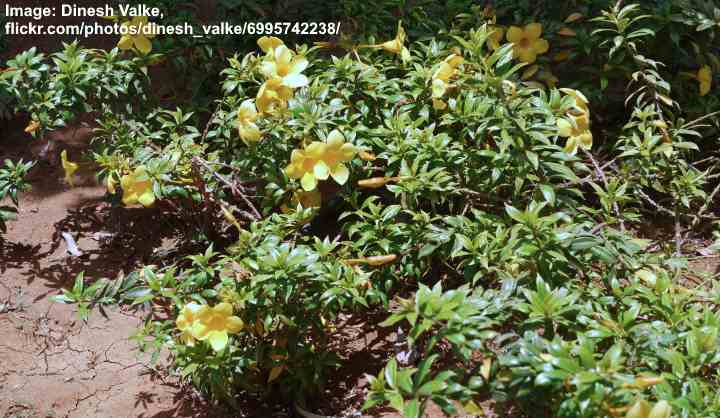
Bush Allamanda (Allamanda schottii)
The bush allamanda is a tropical flowering shrub that blooms for several months with large, yellow funnel-shaped flowers with reddish-orange stripes in its throat. This evergreen shrub has lush foliage consisting of leathery green leaves 2” to 4” (5 – 10 cm) long. Its brilliant yellow flowers are 2” (5 cm) across and cover the bushy plant throughout summer.
The bush allamanda can grow up to 5 ft. (1.5 m) tall and is popular in tropical gardens for adding dazzling colors. The yellow-flowering shrub performs well as a hedge, specimen plant, or foundation planting in full sun. It also attracts hummingbirds and butterflies.
- Mature Size: 4 to 5 ft. (1.2 – 1.5 m) and wide
- USDA Zone: 10 and 11
- Sun Exposure: Full sun
- Soil Type: Organically rich, moist, fertile, well-drained soils
Yellow Flowering Weigela (Weigela middendorffiana)
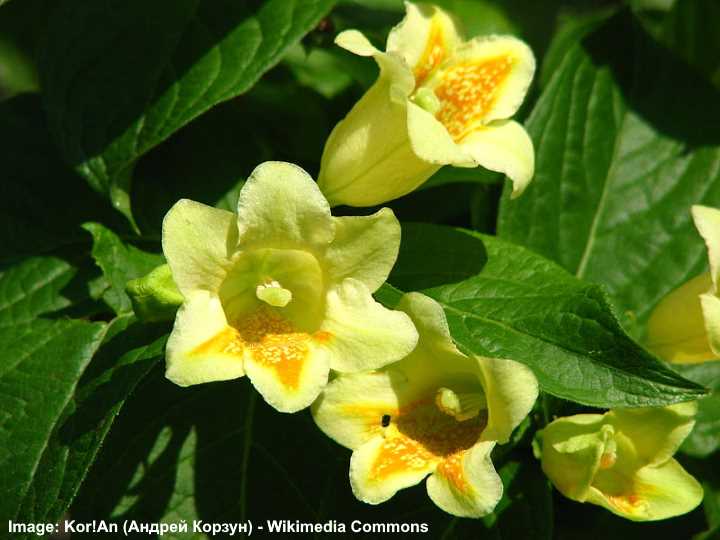
The yellow flowering weigela brings outdoor spaces to life with its beautiful bell-shaped pale yellow flowers with orange markings on the throats. Identifying features of the shrubby plant are its ovate green leaves and soft yellow flowers, which bloom in late spring and early summer. The small yellow-flowering shrub grows up to 5 ft. (1.5 m) tall and wide.
The abundant, showy yellow blooms on this weigela shrub attract pollinators like bees and butterflies. It’s relatively drought-tolerant and requires minimal maintenance. The yellow flowering weigela performs well in garden landscapes in borders or as a hedge.
- Mature Size: 6 to 9 ft. (1.8 – 2.7 m) tall and wide
- USDA Zone: 4 to 8
- Sun Exposure: Full sun to partial shade
- Soil Type: Well-drained, moderately fertile soil
Yellow Jacobina (Justicia aurea)

The yellow Jacobina is a flowering tropical shrub with unique yellow flower plumes. The eye-catching flowerheads are egg-shaped clusters of arching, tubular yellow flowers. The bright yellow flowers bloom from midsummer through early fall, attracting butterflies and hummingbirds. The evergreen shrub has large, dark green, ovate leaves that are 12” (30 cm) long.
The yellow Jacobina grows up to 8 ft. (2.4 m) tall. The yellow-flowering shrub performs well as a foundation planting or specimen plant in warm climates. In cooler climates, you can enjoy the shrub’s unique yellow flowers and foliage in containers to add a pop of color to a shaded patio or decking area.
- Mature Size: 4 to 8 ft. (1.2 – 2.4 m)
- USDA Zone: 9 to 11
- Sun Exposure: Partial shade
- Soil Type: Humus-rich, well-drained soils that are consistently moist
Sweet Acacia (Vachellia farnesiana)

The sweet acacia is a large, multi-stemmed thorny bush with golden-yellow, fragrant puff-like flowers 0.5” (1 cm) across. The unusual yellow-flowering shrub has mimosa-like pinnate leaves growing on zig-zag stems. The dark brown stems also have sharp thorns. Its fragrant yellow flowers and feathery, fern-like leaves add color and texture to tropical landscapes.
The sweet acacia shrubs are highly fragrant and grow up to 20 ft. (6 m) tall. Its blooming time is late winter, early spring, and sporadically throughout the summer. Thanks to its rapid growth and tolerance to humidity and heat, sweet acacia is a popular ornamental yellow-flowering tree in Florida, California, and Texas.
- Mature Size: 15 to 20 ft. (4.5 – 6 m)
- USDA Zone: 9 to 11
- Sun Exposure: Full sun or partial shade
- Soil Type: Loose, dry to medium moisture soils that have good drainage
Winter Jasmine (Jasminum nudiflorum)
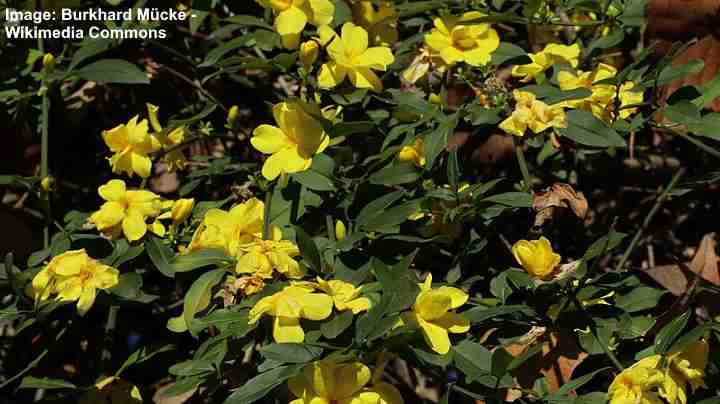
The winter jasmine is a deciduous shrub identified by its five-petalled, star-shaped yellow flowers blooming on arching branches. Characteristic features of winter jasmine are its slender willow-like stems, masses of bright yellow spring flowers, and trifoliate leaves. The vining shrub grows as ground cover or cascades over retaining walls.
The winter jasmine thrives in sandy, loamy soils in full sun or partial shade. This hardy plant is native to China and grows as a shrub up to 4 ft. (1.2 m) tall or sprawling ground cover up to 15 ft. (4.5 m) wide. Its arching branches can create a beautiful cascade of bright golden-yellow flowers to add a splash of color to partly shaded landscapes.
- Mature Size: 4 to 15 ft. (1.2 – 4.5 m) tall and 3 to 6 ft. (1 – 1.8 m) wide
- USDA Zone: 6 to 9
- Sun Exposure: Full sun or partial shade
- Soil Type: Humus-rich, well-drained soils that are consistently moist
Yellow Oleander (Cascabela thevetia)

The yellow oleander is an evergreen tropical flowering shrub with large, showy, bright yellow, trumpet-shaped flowers 3” (7.5 cm) long. This upright shrub has willow-like glossy green leaves, fragrant yellow flowers that bloom during summer and fall, and blackish fruits. The yellow-flowering tropical shrub grows up to 8 ft. (2.4 m) tall.
The yellow oleander is grown as a large shrub or small tree for its ornamental value. Its dense evergreen foliage and vibrant flowers perform well as a hedge, privacy screen, accent tree, or foundation planting. It is tolerant of drought and can withstand hot and dry conditions.
However, it is important to note that all parts of the yellow oleander plant are highly toxic and should not be ingested. Therefore, avoiding planting the shrub where children and pets play is best.
- Mature Size: 4 to 8 ft. (1.2 – 2.4 m) tall and 4 to 5 ft. (1.2 – 1.5 m) wide
- USDA Zone: 8 to 10
- Sun Exposure: Full sun or partial shade
- Soil Type: Rich, sandy soils that have excellent drainage
Carolina Yellow Jessamine (Gelsemium sempervirens)
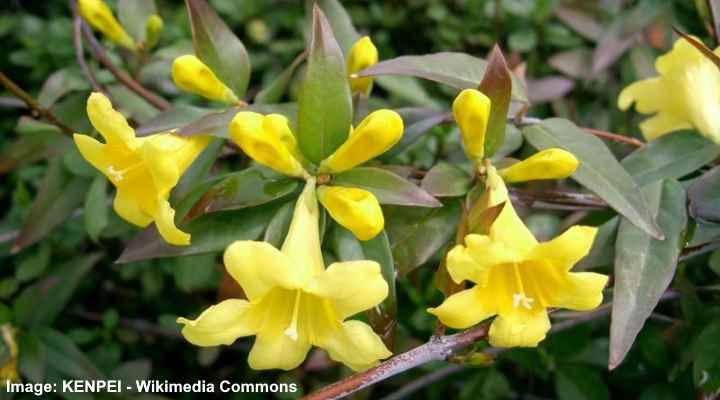
The Carolina yellow jessamine is a climbing yellow-flowering vine you can grow as a bushy shrub. The shrubby vine’s spectacular yellow flowers are trumpet-shaped, sweetly scented blooms. These lemon-colored flowers contrast nicely with the glossy, ovate green leaves. Its yellow trumpet flowers measure 1.5” (7.5 cm), and its leaves are 1” to 3” (2 – 7.5 cm) long.
The Carolina jessamine blooms in late winter to early spring, adding a burst of color to warm climates. The vining climbing stems scramble over arbors, fences, and garden structures. To grow it as a shrub, you can prune the vines. The fragrant flowers also attract bees and butterflies, making it a great choice for pollinator gardens.
- Mature Size: 10 to 20 ft. (3 – 6 m) tall and 3 to 6 ft. (1 – 1.8 m) wide
- USDA Zone: 7 to 10
- Sun Exposure: Full sun or partial shade
- Soil Type: Organically rich, moderately fertile soils with excellent drainage
Butterfly Bush ‘Honeycomb’ (Buddleja weyeriana ‘Honeycomb’)

The Butterfly Bush ‘Honeycomb’ is a stunning deciduous shrub with fragrant golden-yellow flowers blooming profusely at the ends of arching branches. The free-blooming conical flower clusters are on show from summer through fall. It also has lanceolate, gray-green leaves that contrast with the honey-scented yellow-orange flowers.
The yellow-flowering butterfly bush grows up to 7 ft. (2.1 m) tall. Landscaping uses include growing in butterfly gardens, mixed borders, and cottage gardens.
- Mature Size: 5 to 7 ft. (1.5 – 2.1 m)
- USDA Zone: 5 to 9
- Sun Exposure: Full sun
- Soil Type: Medium moisture, well-drained soil
Clove Currant (Ribes aureum)

The clove currant is a yellow-flowering shrub with five-petaled, star-shaped, fragrant yellow blooms. The yellow flowers have a distinctive clove fragrance, bluish-green leaves with three to five lobes, and edible black berries in the summer. The ornamental fruit-bearing shrub grows up to 8 ft. (2.4 m) tall.
The clove currant can be grown as an ornamental shrub, as an informal hedge, or in shrub borders.
- Mature Size: 6 to 8 ft. (1.8 – 2.4 m) tall and wide
- USDA Zone: 4 to 8
- Sun Exposure: Full sun to partial shade
- Soil Type: Fertile, organically rich, well-drained soils
Siberian Peashrub (Caragana arborescens)

In late spring, the Siberian peashrub bursts into life with clusters of brilliant pea-like yellow flowers. This cold-hardy yellow shrub is categorized by its masses of golden-yellow flowers, small green oval leaves, thorny branches, and slender seed pods. You can plant Siberian peashrub as a windbreak, flowering hedges, privacy screens, and for erosion control.
- Mature Size: 8 to 20 ft. (2.4 – 6 m) tall and up to 12 ft. (3.6 m) wide
- USDA Zone: 2 to 8
- Sun Exposure: Full sun to partial shade
- Soil Type: Fertile, organically rich soils with excellent drainage
Yellow Flowering Hibiscus Shrubs (Hibiscus rosa-sinensis)

Yellow flowering hibiscus cultivars have some of the showiest yellow blooms on tropical shrubs. The evergreen shrubs with their trumpet-shaped bright yellow flowers have five large papery petals, prominent yellow stamens, and a deep red throat. The beautiful tropical flowers measure 4” (10 cm) across and contrast with glossy, dark green leaves.
You can plant yellow-flowering hibiscus shrubs as an attractive backdrop in mixed borders to add a splash of color. Yellow hibiscus shrubs perform well as flowering hedges, privacy screens, or specimen plants. In temperate climates, you can grow hibiscus in large containers on your patio or deck and overwinter them indoors.
- Mature Size: 8 to 10 ft. (2.4 – 3 m) tall and 4 to 6 ft. (1.2 – 1.8 m) wide
- USDA Zone: 10 to 12
- Sun Exposure: Full sun or partial shade
- Soil Type: Slightly acidic, well-drained soil
Related articles:
- Ground Cover Plants with Yellow Flowers
- Yellow Flowering Trees
- Stunning Yellow Flowers for Your Garden
